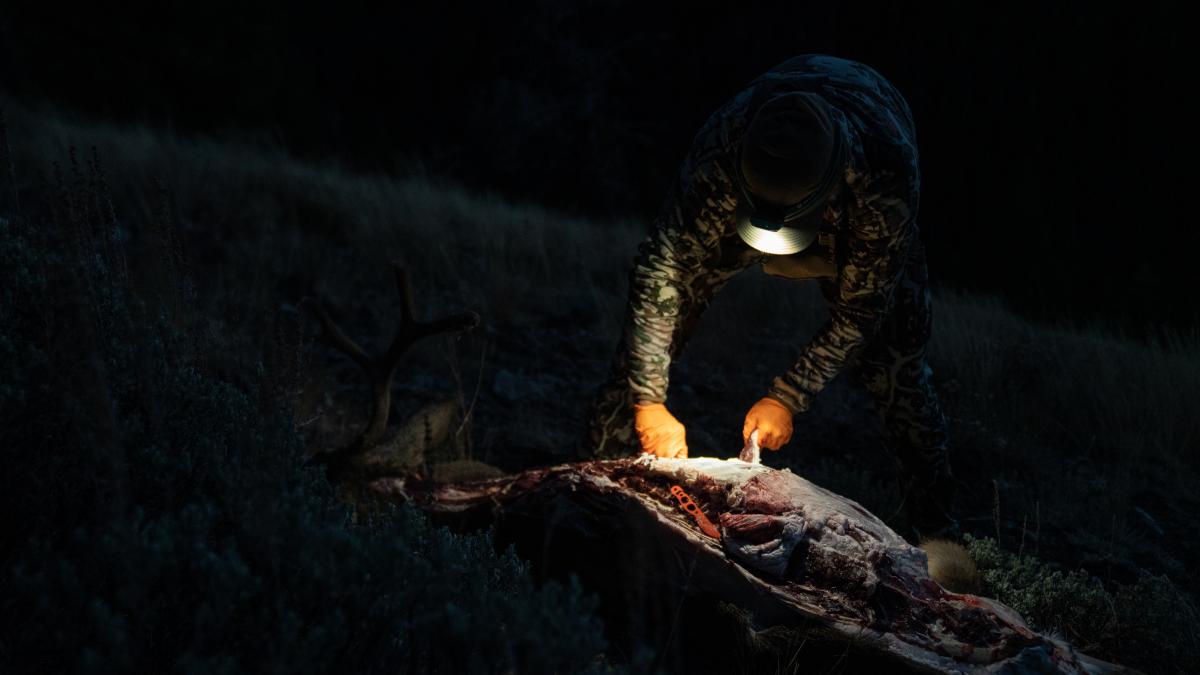
Top Tips for Field Sharpening Your Knife
By Josh Kirchner
Of the many tools in a hunter's toolkit, one of the most important is their knife. A good knife can be used for many things in the field and will pay huge dividends once an animal is on the ground. Knives are not invincible though and are susceptible to natural wear and tear, like suddenly seeming not as sharp as they once were. Animal bone for instance is notorious for dulling blades, and that is something we hunters are bound to run into. Sharpening a knife at home is one thing, but what do you do if your knife dulls in the field? Working on an animal with a dull knife is not only going to breed frustration, it could be dangerous. Muscling against a knife that isn't sharp is a great way to cut yourself, as well as make the process of working on an animal last much longer than it should. A hunter should be able to sharpen their knife right there in the field effectively and get back to business. This will require a bit of know how, and simple tools, but nothing that will frustrate you more than that dull knife.
Sharpen Your Skills Beforehand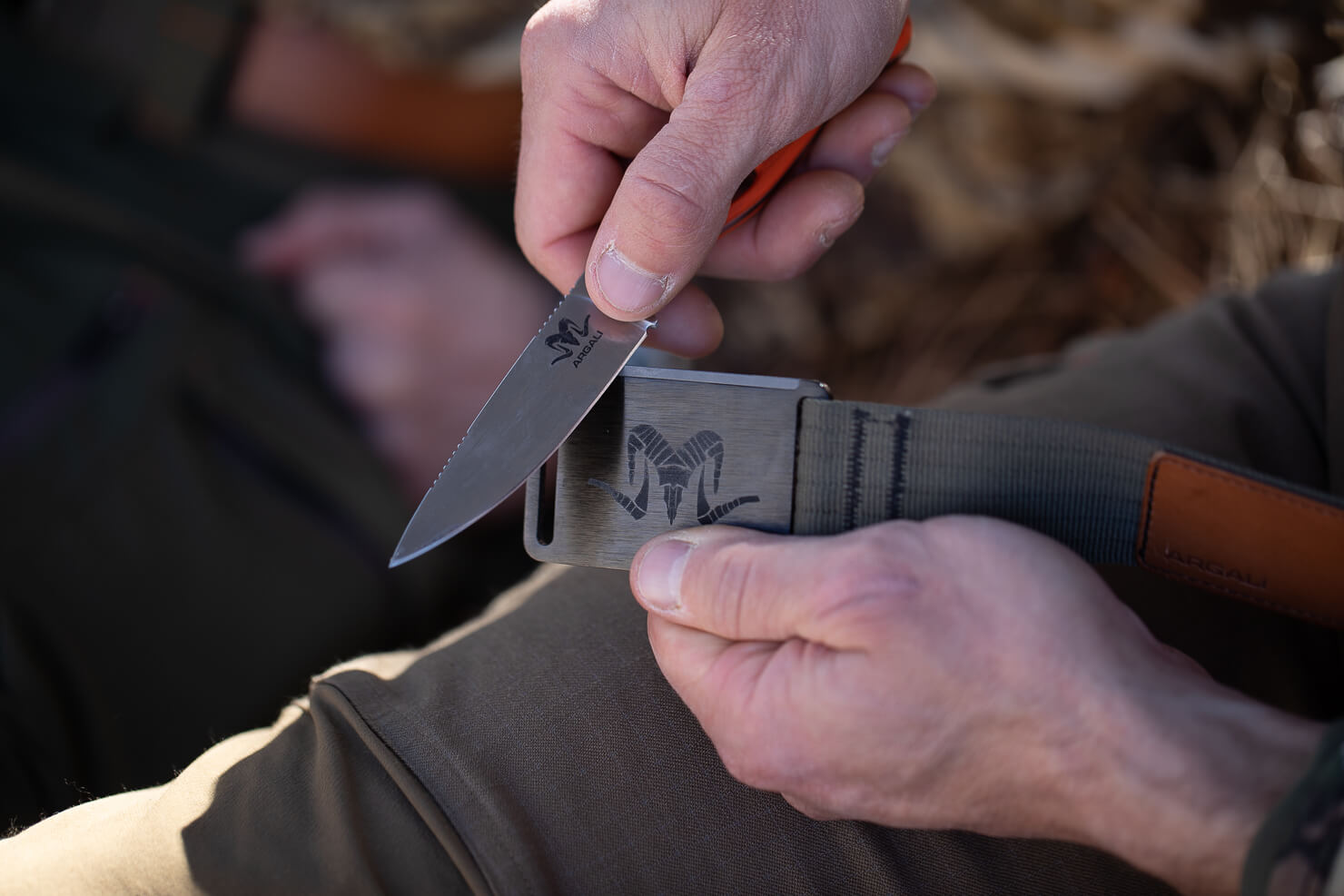
There is often a silent chaos in the air once an animal is laying at our feet, especially when solo. So knowing how to sharpen that knife before entering that particular situation is just going to cause less headache. The skill of sharpening a knife is one of those things that is best practiced beforehand, without the interference of a ticking clock and the fear of meat spoilage. Learn about this at home and then truly try these things out to see what works best for you, your system, and your knife. Things like understanding your bevel angle are going to be crucial to in field sharpening know how. Without the right bevel angle, you might be doing more harm than good. A bevel angle is the degree of angle between the main body of the blade and the sharpened edge. There are some sharpeners that actually come with different bevel angle guides to keep one on track while sharpening.
Stay On Top of Your Edge
So, you've practiced sharpening your knife at home and are ready for mountain life. A few days into that mountain life you find yourself now standing in front of a downed animal needing to be broken down for packing. Time to get to work. Through that work though, it's important to try and stay on top of your edge. As one works through animal hide and bone a knife might start to lose that edge. With a high quality steel like S35VN, when you're knife starts to dull it usually isn't because your edge has "flattened", but because you have micro imperfections like burs, micro bends or you have rolled the sharpened edge of your blade. All of these changes in your edge are not likely things you can see with the naked eye.
By staying on top of your knife edge, we can mitigate dealing with a dull knife. It's much easier to keep a knife sharp than to have to completely re-shape and re-sharpen a knife. Don't wait until you're done with an animal to touch up the blade. If at any time during the process of working on an animal, should your knife start feeling dull, take the time to touch it up right then and there. There's no sense in fighting through a dull knife. Spending 1 or 2 minutes sharpening your knife while butchering will actually save you time butchering and you'll stay ahead of making a dull knife duller.
Ways to Sharpen Your Knife in the Field
Pocket Sharpeners
There are a whole host of pocket sharpeners out there with a different materials that can be used to sharpen your knife. A pocket sharpener can be anything from a ceramic rod to a carbide V. These are great for packability and simplicity on backcountry hunts. Just be sure to practice using said sharpener beforehand, so you don't do more harm than good when there is a need to sharpen your knife in the field.
Stropping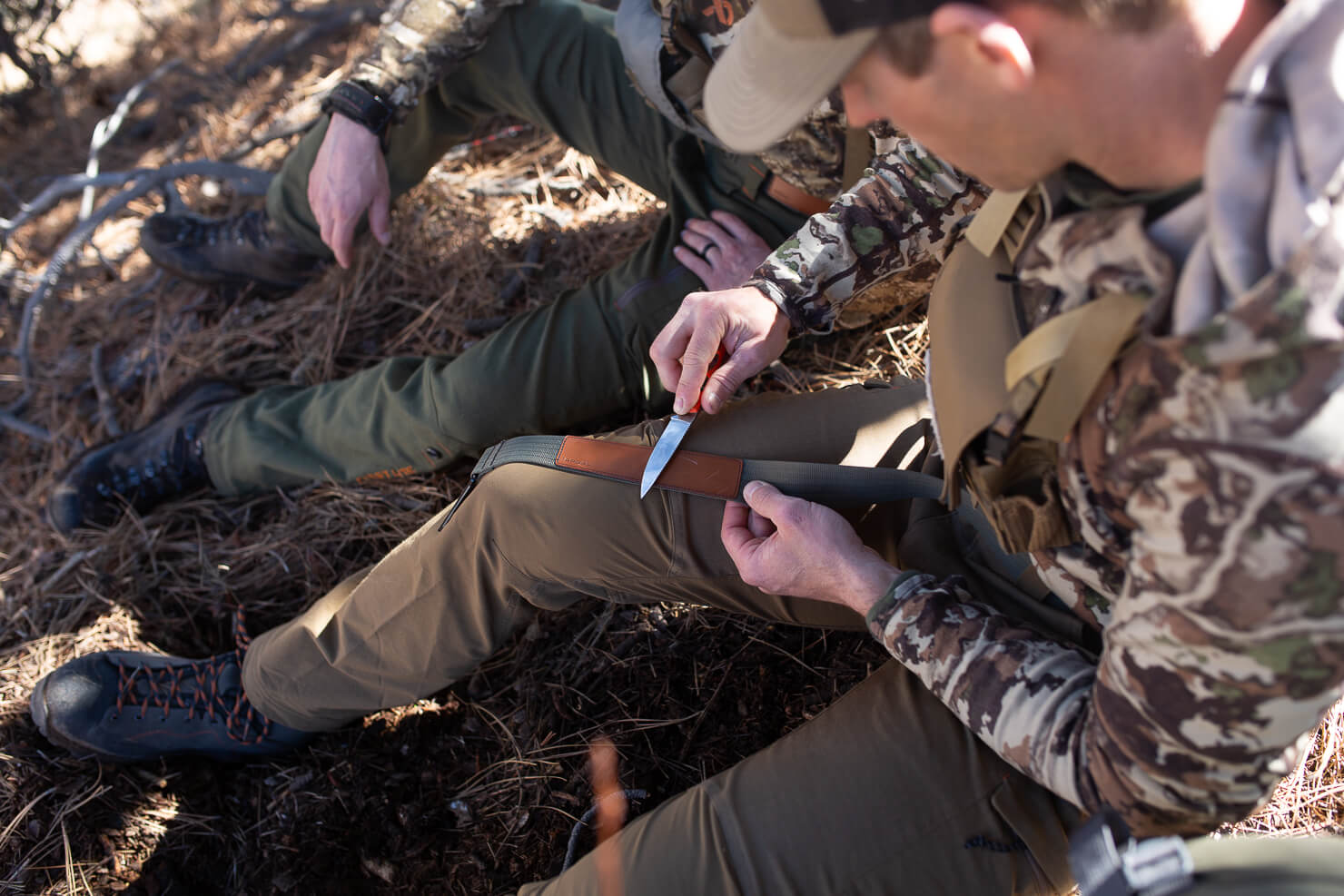
Stropping a knife is our favorite way to stay on top of a knife edge, particularly in the field. Stropping is accomplished be "pulling" your knife along a stiff piece of material away from the sharpened edge. When you strop, what you are doing is literally bending out imperfections in the infinitely small sharpened edge of your knife.
Stropping is most commonly done with a piece of leather (vegetable tanned leather works best because it is stiffer), but stropping can be done with any stiff piece of fabric or material. The key is to put a piece of fabric or leather on top of a solid surface, such as a tree or the top of your thigh. With light pressure and making sure to hold the knife at the correct bevel angle of your blade, pull the knife 5-10 times along the stop surface. If you do it correctly, you will be surprised by how effective stropping works.
Note: If you are using a softer steel knife and your knife edge has been flattened, stropping will not work and you will need to re-shape your edge.
Car Window
Yes, your car window can work to sharpen your knife. Ceramics and glass are made from the same material, and if you ever find yourself in a pinch without a sharpener, roll down your window until the top of it is coming out of the door. Once you've done this, run your knife at the proper bevel angle along the top edge of your window. It will work better than you might imagine.
Now, let's chat about ways to sharpen your knife in the field. The way one sharpens a knife is going to be a reflection of what sharpener they bring along with them. There are many pocket type sharpeners out there that one can buy. These can be great, but they are not without flaw. One of the problems with some of these is that they make it very easy to not sharpen a knife correctly. In fact, a person could be doing more bad than good. For instance, the famous pull through carbide V makes drifting from that 20 degree bevel incredibly easy. A steady hand goes a long way, but we are not perfect. If using one of these, 8-10 steady pull throughs should get you going again. The amount of pull throughs to get what you want is really going to depend on the steel though. Harder steels are going to require more reps through the V.
And then there is the commonly used diamond grit sharpeners. More times than not, these are much too aggressive for most in field sharpening jobs, as these are made for reshaping a blade. With higher quality steel, this shouldn't be an issue in the field, and is more suited for at home sharpening. With that being said, if you do need to re-shape your blade, this is how you'd do it.
- Start with about 5-10 swipes on one side of the blade at the proper bevel angle.
- Now, run your finger perpendicular to the blade starting at the side that was facing up when sharpening. If you feel a slight hang up or bump, mission accomplished, as this is called a bur. If you don't feel this, then run a few more swipes until you do.
- Repeat the process on the other side an equal number of times.
- After that, run the blade over a much finer material like a ceramic alternating sides of your knife.This process will remove the bur and fine tune your edge. How many times you need to do this will depend on the steel and your sharpener, but start with 10 strokes on each side, and keep repeating until your knife is sharp.
In all reality, with a high quality steel, there should be no reason to be reshaping a blade in the field. A less aggressive approach is more suitable for field sharpening.
We need to pick the right tool for the job. Luckily, we don't need a whole lot when it comes to staying sharp in the field. Remember, we aren't looking to completely re-sharpen a blade, we are merely looking to stay on top of the edge. With high quality steel like S35VN the job is anything but laborious. A few swipes on a leather strap or ceramic stone is enough to keep you in business. And don't feel like you need to press down super hard on these either. Light pressure is fine. 5 swipes on each side with one of these should be enough to get up and running again. Remember with the leather strap, you'll want to start with the sharpened edge facing you and then swipe away from you. And for the other side, you'll start blade away from you and swipe towards you. If trying to go edge first, the blade would just cut the leather. These are fine sharpeners that aren't too aggressive, like that of diamond grit. Remember to know your bevel angle when using any of these. If you don't know your bevel angle and are using these things, you're wasting your time. And in a pinch, should you not have something like ceramic or a leather strap, the top of your car window will work. Roll that baby down a bit and run a few swipes with your blade across the top. The glass is hard enough to get that edge back. Of course, this isn't something we'd recommend doing all of the time, but ya gotta do what ya gotta do sometimes!
Know Your Steel and How Different Sharpeners Work
Along with staying on top of your edge and the different ways of sharpening it's important to know your steel and how these sharpeners work. Not all steels are created equal and not all sharpeners are for all jobs. The harder the steel, the longer it will hold an edge. While that sounds all fine and dandy, some steels are so hard that it's difficult to touch that sucker up. S90V for instance will hold an edge great, but once it's gone, you'll have a tussle on your hands getting that thing sharp again. In that case, it's even more important to stay on top of your edge, as to not lose it. S35VN is a steel that will hold an edge great, but is not as hard as S90V. This means that you'll be able to get your edge back much easier in the field. So, know your steel before heading out and act accordingly.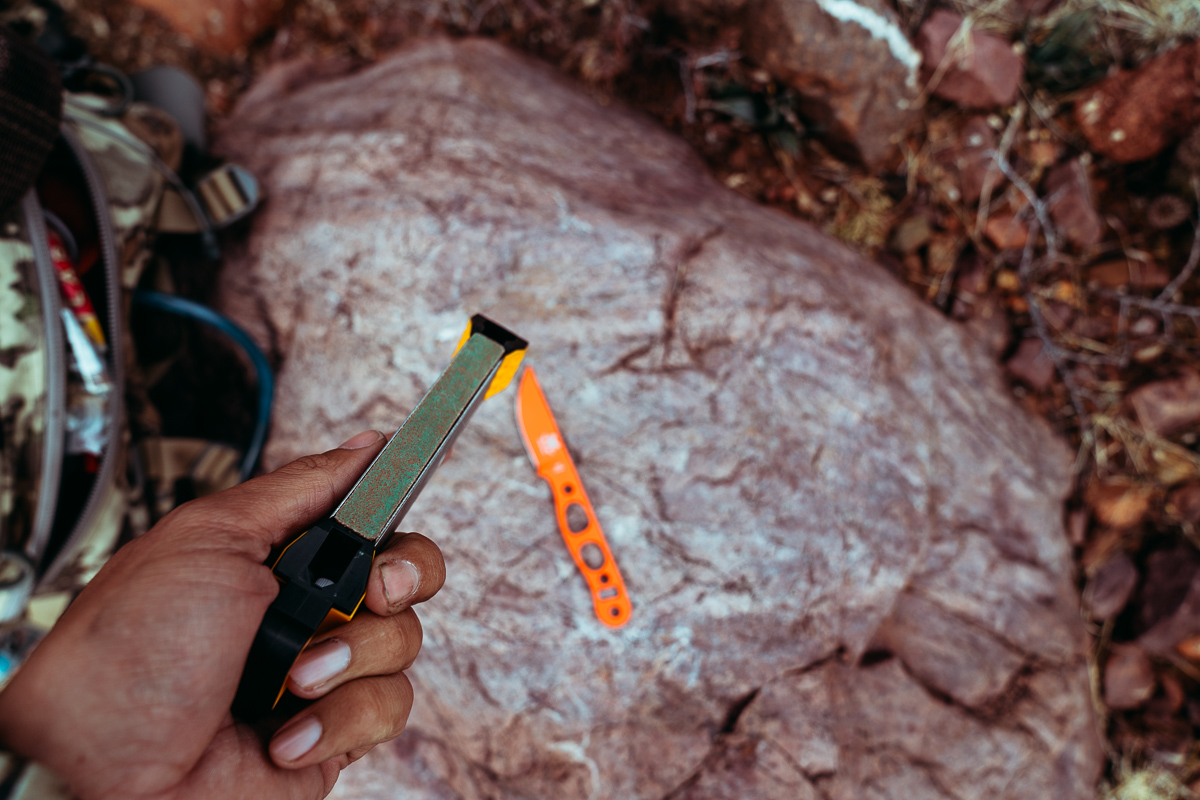
When it comes to the different sharpeners out there, knowing which is best for what is going to make your life, and your knife's life much easier. Once you get the hang of it though, it's as easy as knowing you need a screwdriver vs. a hammer. Diamond grit sharpeners are probably one of the most common out there. It's that shiny plate you might have seen. These come in different grits. The more coarse the grit, the more material(steel) it will actually remove from your blade. These are really more for tough sharpening jobs for a knife that has truly been neglected. For in field use, something like a leather strap or ceramic stone is really going to fit the bill. These aren't aggressive and will finely hone that edge back to its original position.
By knowing the relationship between both steel and sharpener, you'll be much better equipped heading into the field.
Closing Thoughts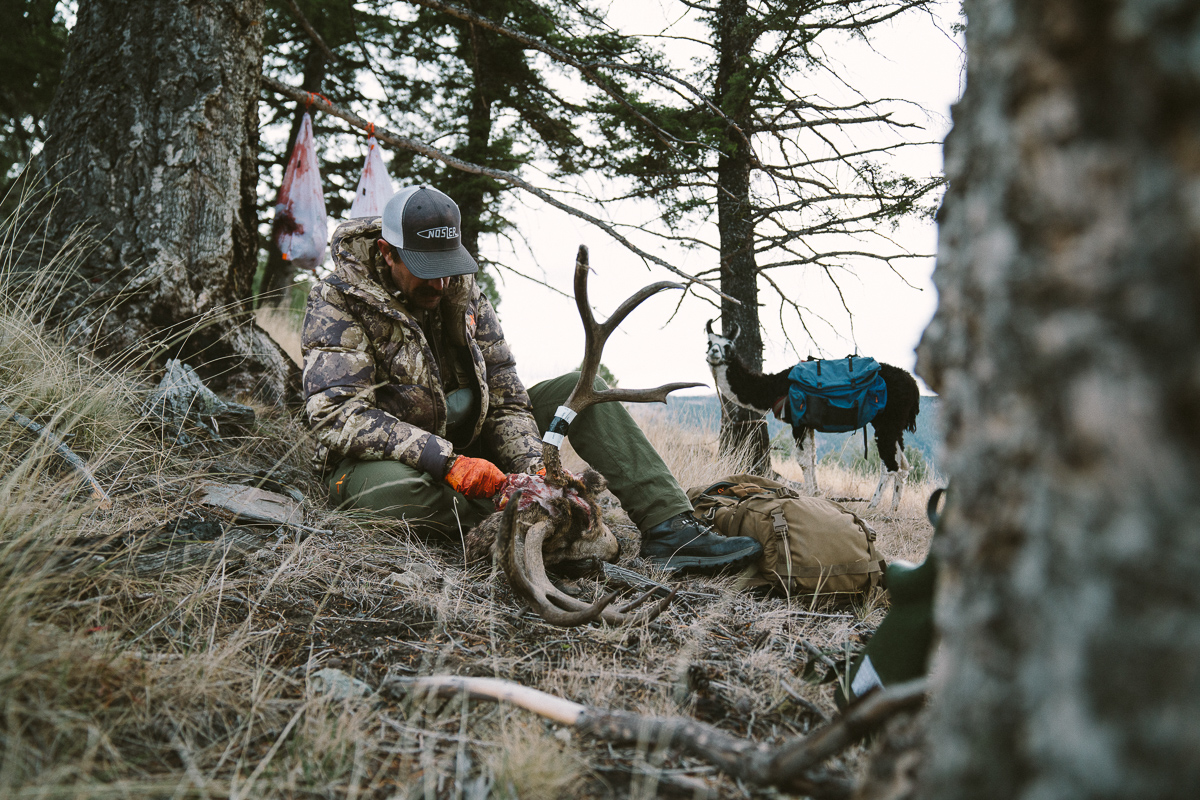
Whether it's separating hide from animal or working through tough joints, our hunting knives get put through the ringer and than back again. And I'd venture to guess that 8 out of 10 hunters probably don't know how to properly sharpen those knives. Having this in the field sharpening know how is a skill that every hunter should have in their pocket. And by doing so, you'll smooth out the experience of processing an animal. It's hard enough just going through the motions of working on say an elk. A neglected blade will make that even harder. We should be working with our knives, not against them. And if we take care of our knives, they will take care of us.
For a killer field sharpening option, check out our Argali Kodiak Belt. It's a belt and field sharpener in one ultralight and practical package. The Kodiak comes equipped with a tungsten carbide sharpening bar, 800 grit diamond plate along the back of the belt buckle, and a 6" vegetable tanned leather strop. All of this gives a hunter the ability to shape, sharpen, and hone any knife, broadhead or hook.